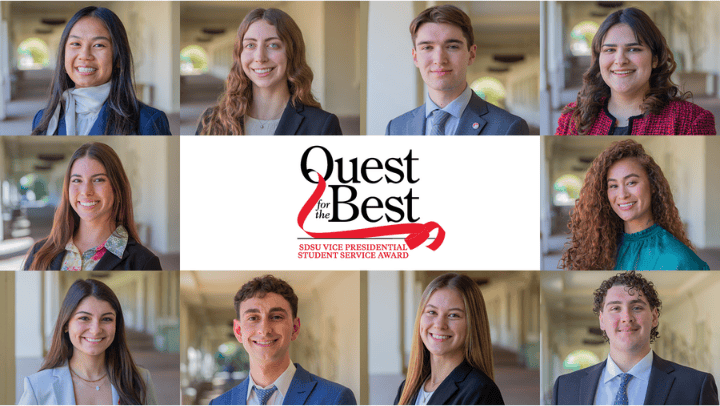Off the Beaten Course: SCI 596
This course brings students to Guatemala to explore a vast array of scientific topics.

Off the Beaten Course is a series that delves into SDSU's course catalog to share unique and non-traditional classes.
Course Title: Interdisciplinary Sciences Immersion in Tikal, Guatemala
This winter break, Estralita Martin, assistant dean for the College of Sciences, will lead a student trip to Guatemala to explore a vast array of scientific topics in the country, including biology, ecology, geology, astronomy, psychology, mathematics, biodiversity and community health.
Students will see Mayan ruins and attend a traditional Mayan ceremony, explore the Uaxactun jungle, hike Pacaya volcano, visit the Museo Santa Barbara, and have many other cultural and scientific experiences — all while earning three credit units. The trip is January 8 through 17 and costs $2,590, which includes accommodations, meals, tours and transport within Guatemala; it doesn’t cover airfare to and from the country.
The program is open to students as well as the community. If you’re interested, the daily itinerary, photos and application is on the Aztecs Abroad website. But hurry; the application deadline is Oct. 15.
1. What inspired you to create this course?
I love taking student groups abroad to see science outside the classroom. I am part of an organization called MHIRT that stands for Minority Health Disparities International Research Training. It’s a national program funded by the U.S. government that helps students from underrepresented cultural groups learn about doing scientific research outside of the country. Going to countries that are not as equipment-endowed as the U.S. shows them quality research can still be done with minimal equipment. In the MHIRT program, the students go and spend eight weeks doing research. I lead a group that goes to Cape Coast, Ghana and they’re doing ethnobotany, looking at the plants that have been used for eons to treat diseases. We know it works, but no one really knows what the chemical is in the plant that’s making it so effective.
Recently, I went to Guatemala with SDSU students, faculty and administrators from the College of Education. We have science majors who want to be educators, and students went there to investigate the education system and to participate in community service projects. While talking with the folks in Guatemala, I saw the biodiversity, environmental science and geology would be of great interest to College of Sciences students. Also, I wanted to explore more of Guatemala!
2. What can students expect to learn?
There is so much. I’ll only mention a few things. We’re going to be looking at geological issues, because in Guatemala alone there are over 20 volcanoes. We’re going to hike the famous Pacaya Volcano. Students are going to have the chance to go to an “observatory,” and I’m putting that in quotations because there’s no telescope there. The altitude is high enough and the sky is clear enough that you can see the stars without using a telescope. The mathematicians will be interested because we’ll be going to Mayan ruins and looking at the math behind the set-up of the city.
Guatemala had a civil war that ended in the mid-1990s, so we’re going to be dealing with the psychological aspects of the military, the rebels and the poor people in between who were just trying to dodge bullets and hold onto their land.
3. Is there any facet of the trip that you’re particularly looking forward to?
I’m all about biology so I am very excited about watching families of primates in the trees. Who can resist that? And the diversity of tropical birds is mind boggling. Although I’ve been with student groups in Guatemala before this will be my very first time seeing the UNESCO World heritage site of Tikal; it has been a lifelong dream to see the Mayan pyramids and temples.
The gum extraction process in the rainforest is also going to be fascinating to watch. Before China was able to manufacture it more cheaply, gum came primarily from Guatemala. Whole cities and towns are involved in the processing of gum, so the students can look at that, but also the impact it has on the rainforest is significant. We’re really incorporating all of our sciences into this trip.
I love that we are going to see such a wide diversity of environments. From small villages to the colonial towns of Flores and Antigua; from a rainforest to a volcano … this is going to be an unforgettable trip.
4. Why should scientists study abroad?
The science majors don’t get out as much; they’re in their books. With all the global issues going on, if we as scientists are not apprised of what’s going on elsewhere, some of our discoveries might be more harmful than good. If we continue to be apolitical, we’re definitely not going to get a say as to how our discoveries are used, and that’s not a good thing. Science doesn’t work in a vacuum. It always has a trickle-down effect. It doesn’t just affect our knowledge; it affects how people use it and what happens to them as a consequence.
For more information on the Interdisciplinary Sciences Immersion in Tikal Guatemala, please contact Maureen Crawford, international coordinator, College of Sciences, at (619) 594-1813.



